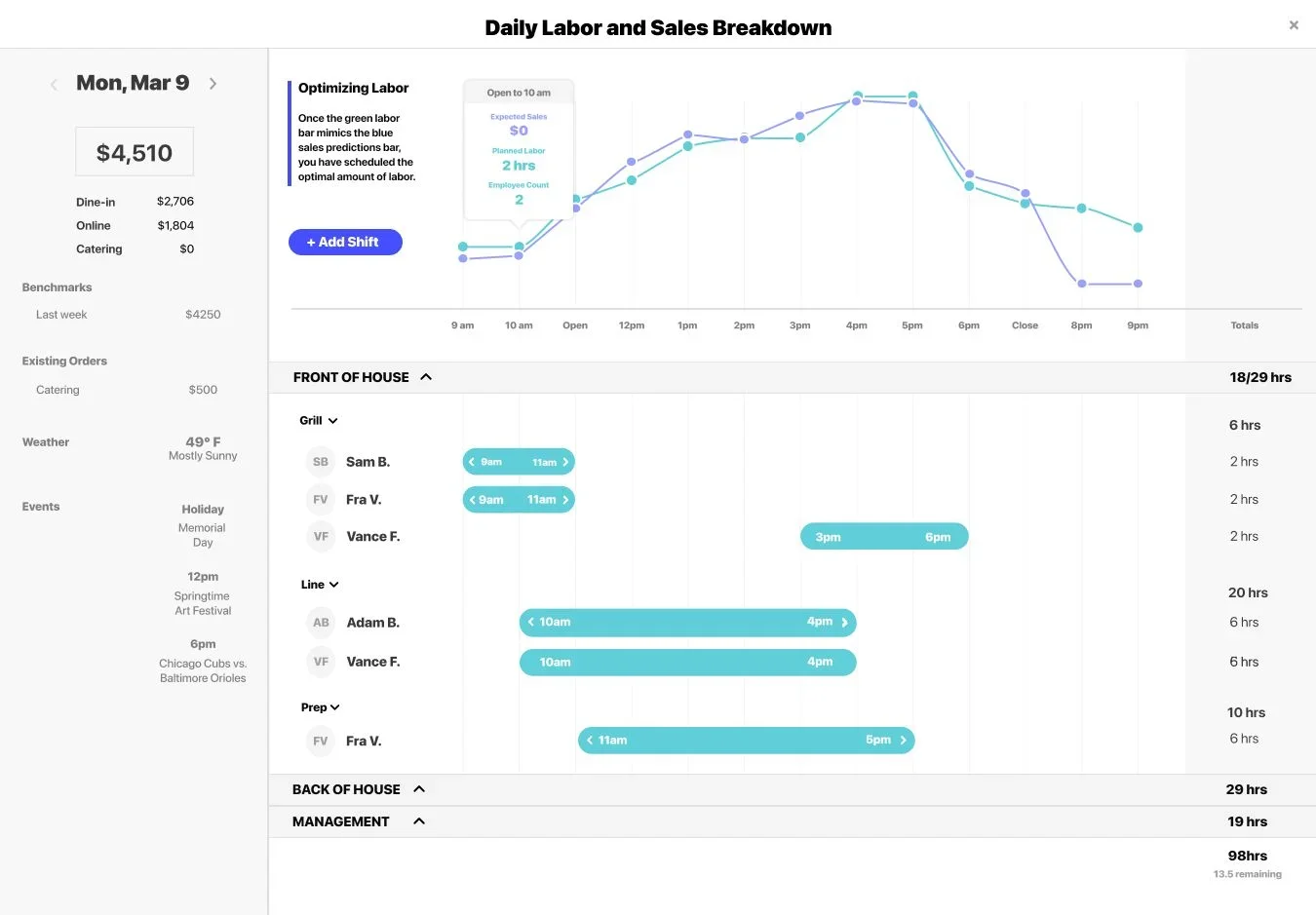In the bustling world of the restaurant business, the delicate balance of providing exceptional food and service, while effectively managing restaurant expenses, is a constant juggling act. A key player in this balancing act? Labor costs. These costs, encompassing salaries, benefits, training, and even the indirect expenses associated with employees, are often one of the largest chunks of a restaurant's budget. As such, forecasting labor costs becomes an essential ingredient in the recipe for a restaurant's financial success.
However, the varying nature of labor costs – influenced by seasonal trends, changing customer preferences, fluctuating food costs, and evolving labor laws – makes this forecasting a complex, yet vital task. The unpredictability of the restaurant industry makes it even more essential to develop a thorough understanding and an effective method for forecasting these costs.
Whether you're a seasoned restaurateur looking to improve your cost management, a restaurant manager seeking to strike a harmonious balance between staff and budget, or a culinary entrepreneur navigating the financial landscape of the restaurant industry for the first time, this article is for you. So, let's take a deep dive into the world of labor cost forecasting in the restaurant business. Your path towards improved financial planning starts here.

Restaurant Labor Costs Forecasting Techniques
There are many techniques a restaurant owner can use to forecast labor costs for their business. The right method they use will largely be shaped by the nature of their business, available data, and market factors. Here are five different restaurant labor cost forecasting techniques.
1. Market Research Labor Costs Forecasting Method
The market research labor forecasting method leverages data from other restaurants to provide insights into the future staffing needs of a restaurant. For instance, a prospective entrepreneur may research restaurants in the same niche and area of operation. The data they collect will help them understand the staffing needs of restaurants, fluctuations in labor demand and supply, and seasonal trends throughout the year.
This method of labor forecasting relies on networking with other restaurateurs to get accurate data. Aside from the data, the restaurateur must also benchmark labor and staffing data and get location-specific tips from other restaurateurs.
Many variables that influence the accuracy of labor costs forecasting data derived from market research. For starters, no two restaurants are the same, even when they have a similar menu and operate within the same area. Secondly, new restaurants often face different challenges in the labor market compared to operating restaurants with a loyal fan base.
2. Historical Analysis Forecasting Method
A restaurant that is already operational may use data from previous months to forecast its future staffing needs. By scrutinizing and comparing common trends, a restauranteur can determine the number of employee shifts they may need at different times, days, or seasons.
Carrying out historical analysis is extremely helpful for restaurants already in operation. This method provides more accurate data for forecasting and can be invaluable in determining the busiest and slowest times to schedule staff. Using data from previous sales resorts, point-of-sale (POS) systems, and other records, restaurateurs can compare customer habits and sales trends to accurately forecast labor demands for meal times, during special events, or times of the year.
3. Delphi Labor Forecasting Method
Large and chain restaurants with multiple managers and a head decision maker can use the Delphi method to forecast restaurant labor needs and costs. Also called the Estimate-Talk-Estimate method (ETE) method, the Delphi technique is a qualitative and systematic forecasting method that involves collecting signed or anonymous opinions from stakeholders and experts through multiple rounds of questioning. At the end of these questions, the forecast is passed on to the overall decision maker for approval.
For instance, a restaurant with a team of managers can use surveys to estimate their location's future labor needs and costs. The restaurant's leadership can then make informed hiring and staffing decisions based on the managers' responses.
4. Advanced Quantitative Forecasting Method
This labor and labor cost estimation technique relies on historical data to identify patterns and trends that influence future needs. Typically, the approach is very inclusive and factors in market conditions, economic fluctuations, sales records, transactional data, and labor demand and supply to assess future labor costs.
Unlike historical analysis forecasting, advanced quantitative methods are mathematical assessments performed by unique analysis software. This method is popular among large organizations such as chain restaurants operating across the country because of their access to diverse data sources and the need for in-depth analysis.
Try Lineup.ai’s machine-learning sales forecasting software, designed exclusively for restaurants.
5. Software-based Labor Forecasting Method
The high demand for accurate labor cost forecasting in the restaurant industry has led to the development of industry-specific forecasting software. These tools gather data from diverse sources to accurately predict future labor requirements and costs.
These labor forecasting software leverage historical and real-time data to chart labor patterns and anticipate outcomes. The best of these tools factor in the restaurant's specific food costs and sales data, as well as external factors, including seasonal trends, location-specific and national events, and even weather forecasts to predict labor demands.
One of the best tools in the market, Lineup.ai, goes a step further. The software uses machine learning to generate hourly, daily, weekly, and seasonal labor costs forecasts with high accuracy. As it learns, the platform gets better at anticipating fluctuations and integrating the restaurant's objectives and marketing strategies.
Lineup.ai empowers directors and higher-level executives to establish desired labor cost objectives, enabling them to establish managerial controls for each location responsible for schedule creation. By customizing the labor percentage cost in relation to sales, directors and above gain the ability to oversee and regulate labor costs across multiple locations. Lineup.ai ensures that general managers (GMs) are held responsible for adhering to the labor budget and target during restaurant schedule creation.

Steps to Forecast Restaurant Labor Costs
Now that you know the different forecasting methods, let’s look at a more manual option you can try on your own.
Step 1: Categorize Labor Costs By Salaried And Part-Time
Many operations in a restaurant have labor-related costs that are more difficult for managers to compute directly. For instance, salaried labor costs are different than part-time hourly staff. The first step in forecasting labor costs is to divide all the direct costs into categories that make them easy to calculate. The general categories of labor costs include:
- Full-time employees (payroll cost)
- Management (payroll cost)
- Substitute employees (payroll cost)
- Overtime (variable cost)
- Part-time employees (payroll cost)
- Fringe benefits (fixed cost)
Step 2: Calculate Average Cost of Hourly Labor
Beyond hourly wages, the benefits you offer have a cost attached. It’s not always easy to quantify. Here is an example scenario of calculating the cost of each hourly employee based on a minimum wage of $10.00 working 40 hours a week.
- Total annual salary ($10 x 40 hours x 52 weeks*) = $20,800
- Cost of substitute for 10 days sick days, 10 paid vacation days, and 5 holidays = (25 days x 8 hours) x $7.25** = $1,450
- Add $1,200*** in payroll taxes = $2,650
- Employee meals at $5 = $1,300
- Employer taxes*** = $2,512
- 50% employer group health insurance premium = $1,830
- Retirement contributions if matching is offered = $1,924
- Uniforms and laundry estimated at $500 per year
- Employment commission and any worker bonuses estimated at $500
The total labor cost for an hourly employee comes to $32,016
Estimating that the employee works for 235 days, the overall labor cost = ($32,016 / 235 days) = $136.24 per day or $17.03 per hour. If the employee is productive only 60% of the time, the actual cost would be $28.40 per hour.
*You should factor in your average time off and vacation days for a more accurate week count.
**$7.25 is the federal minimum wage for tipped employees according to the Fair Labor Standards Act
***Note that taxes will vary greatly based on the restaurant's location. Please consult your accountant to estimate taxes for your state more accurately. These examples are for informational purposes only and are not financial or legal advice.
Step 3: Calculate Average Cost of Part-Time Employee
Based on a minimum payment of $10 per hour and working 8 hours a day, a part-time employee earns $80 per day.
Add the benefits the employee enjoys. These include:
- Meals at $5
- Employee taxes at 7.65%*** = $6.12
- Uniforms and laundry = $3
- Employment commission and worker compensation = $1
The total costs per day = $94.12 or $11.89 per hour
If the employee is productive only 60% of the time, the actual cost of labor for a part-time employee is $158.53 per day or $19.82 per hour.
***Note that taxes will vary greatly based on the restaurant's location. Please consult your accountant to estimate taxes for your state more accurately. These examples are for informational purposes only and are not financial or legal advice.
Step 4: Factor in Historical Labor and Sales Data
The cost of labor is only one variable in forecasting labor costs for a restaurant. The next step is determining how much labor the restaurant requires based on sales projected. To find this figure, check with your POS or any records you have. For a new restaurant, research data from the competition may help establish more accurate estimates.
For more accurate labor requirement data, consider:
- Times, days, and seasons when the restaurant serves the most customers
- The times, days, and seasons when traffic is slowest
- Specific days or seasons when the restaurant gets busier or slower
- Local events, holidays, and weather conditions that affect sales in the restaurant
Note that these elements that influence labor demands may also influence labor supply, hence hourly rates. If your restaurant has been in operation for over a year, you can collect data from past sales, restaurant POS systems, payroll, and any other records you keep.
Check out our free labor and sales forecasting calculator for restaurants.
Step 5: Work with Prime Cost to Forecast Labor Costs
The prime cost is the total cost of goods sold and labor. This figure is critical in establishing how much it will cost to run the restaurant weekly or monthly.
The cost of running a restaurant varies based on the type of restaurant, size, and other factors. As a general rule, the prime cost should range between 50% and 60% of weekly or monthly sales. This, however, may vary from one restaurant to another.
For instance, a fast food restaurant may record a 50% prime cost, while a fine-dining restaurant could have a prime cost as high as 75%. Overall, the labor cost should make up between 15% and 20% of the prime cost.
Completing these steps can get you started with better labor forecasting. However, there’s also an easier way: Lineup.ai’s machine-learning forecasting software compiles all relevant data for you and makes it easy to plan labor with profitability in mind.
Through your forecasting, you might identify a need to better control labor costs.

Accurately Forecast Your Restaurant's Labor Costs
For many reasons, it is harder to start and run a restaurant today. If you run or plan to open a restaurant, optimizing labor costs will make all the difference in your profitability.
While you can opt to do things the hard way with pen and paper, using new restaurant forecasting software is easier, faster, and provides more accurate estimates. Visit Lineup.ai to discover how this machine-learning platform can help you optimize restaurant labor costs.

The team at Lineup.ai is composed of seasoned professionals who hold deep insights into the unique challenges and pain points of the restaurant industry, and are equally skilled in artificial intelligence, machine learning, and data analytics. This fusion of expertise enables Lineup.ai to create cutting-edge AI solutions specifically tailored for the restaurant sector. The technical and analytical prowess of the team, combined with a deep understanding of the unique challenges faced by restaurants, forms the cornerstone of the company's innovation. The team at Lineup.ai also excels in communicating the benefits and applications of AI and machine learning to businesses, ensuring clients fully leverage the capabilities of these solutions.
More about the author